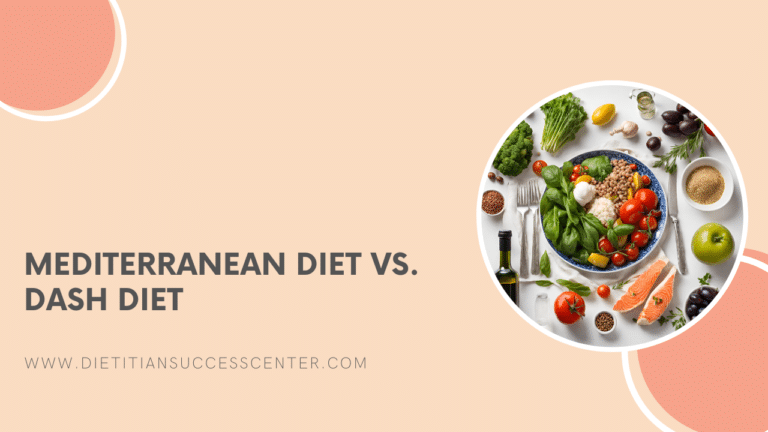
Written by Nicole Krause, BSc, MAN(c), dietetic intern
Reviewed by Krista Kolodziejzyk, RD, MPH, MBA
Are you a registered dietitian (RD) wanting to learn more about meal planning and how to support your clients with their nutrition goals? In this article, we discuss the essential role that dietitians play in supporting our clients towards building meal planning skills.
The Dietitian Success Center membership includes access to the meal planning course. Learn even more about meal planning and get access to ready-to-use resources including our printable meal plan guide with the nutrition basics, build-a-meal ideas, a weekly meal planner and grocery list, easy recipes, a build-your-own salad guide, a build-your-owl grain bowl guide, and how to adapt for cultural food choices.
What is meal planning?
Meal planning can be defined as planning the types and amounts of foods specific to an individual’s preferences and nutritional needs, often developed in collaboration with a dietitian (1).
Meal planning is often seen as giving clients a list of foods they can and cannot eat, but it goes much beyond this. Meal planning aims to teach clients the skills to plan realistic and attainable meals that meet their individual nutrient needs, rather than simply making the plan for them (2). It’s about outlining your nutrition recommendations in an easy-to-follow way and teaching your client to use their knowledge to put these recommendations into action. Often, nutrition knowledge and education are not enough to elicit behaviour change (3). Clients need skills and abilities to translate this knowledge into practice, which is done through meal planning (3). In addition, many find that meal planning is a barrier to their diet, so collaborating with a dietitian may help clients reach their nutrition goals (3).
Meal plans can include hand-picked recipes designed to meet your client’s needs and a template to fill out in collaboration (2). Allowing clients to choose their recipes to take control of their own nutritional choices can may help empower them (2). Meal planning can be used in various settings; for one-on-one consults, group programs, workshops, grocery store tours and more (2). In addition, it can be used for clients with specific nutrient needs such as athletes and those with medical conditions, or for those who need guidance on what and when to eat (2).
Why should dietitians know about meal planning?
After a new diagnosis, oftentimes a client’s biggest barrier to meeting their nutrition goals is putting their new nutrition knowledge to practice in their everyday lives. As dietitians, educating and collaborating with clients about meal planning skills can help to increase confidence and nutrition knowledge, reduce perceived barriers, and improve nutrition habits (4).
Although the Canadian Community Health Survey (CCHS) found that 62% of Canadians regularly meal plan and 74% plan a grocery list before shopping, many people could still benefit from increasing their meal planning skills (5). Meal planning can influence people’s food choices and behavior, and can lead to a healthy diet through knowledge acquisition (5).
Overall, meal planning has the potential to:
-
- Reduce stress – clients won’t be wondering what they should eat every night
-
- Save time – streamlining cooking efforts will free up time in their week
-
- Save money – typically, the price per home-cooked meal is less than buying takeout or pre-made meals
-
- Ensure more nutritious meals – meal planning ensures control of balanced meals by planning ahead, instead of reaching for takeout meals
-
- Reduce food waste – meal planning allows clients to get a better sense of what they need each week and allows them to use up the foods they buy before they spoil (6)
The Benefits of Meal Planning
Improvements in Perceived Barriers
Educating clients about meal planning topics such as the plate method, using food staples, and how to put together a balanced meal can decrease perceived barriers to planning nutritious meals, such as time, cost, and lack of nutrition knowledge (4). Educating clients about similar topics can also increase meal planning confidence (4).
Improvements in Diet Quality
Clients who practice meal planning can increase the frequency of nutritious meals made at home, are more likely to adhere to nutritional guidelines and consume an overall greater variety of food (4, 7). Many studies have found that those who plan their meals have higher fruit and vegetable consumption compared to those who do not (4, 8, 5). This is significant, as 75-90% of Americans don’t meet the recommended fruit and vegetable intake (4).
Reducing food waste
Meal planning can help to reduce food waste, as it limits excess food purchasing and over portioning food, encourages the consumption of leftovers, and considers proper storage of food (9, 10, 11).
Better Family Outcomes
Parents of young children can be overwhelmed by meal planning and often seek advice on how to plan quick and nutritious meals (4). Educating parents about meal planning has been shown to increase positive attitudes toward meal planning, shopping, and cooking (12). Additionally, a study found that when parents meal plan, this significantly increases the likelihood that their family will eat together (13).
Which Clients Benefit From Meal Planning?
All clients can benefit from meal planning guidance.
Certain populations have been shown to be more likely to plan meals including people under age 50, families with children at home, individuals with post-secondary education, and those with a higher income (5). In fact, 68% of Canadian children are involved in grocery shopping with their family, and 67% make suggestions for their family meals (5).
When considering your target client, it’s important to adapt meal suggestions so that they are culturally appropriate to respect your client and ensure client-centered care. The DSC Meal Planning Guide can be freely edited in Canva so that dietitians can adapt the foods and meal ideas to the cultural preferences of their audience.

Types of Meal Planning
When educating clients about meal planning, there are a variety of schedules depending on their preferences and lifestyle. Meals might be prepared on a weekly basis, every 2 or 3 days, or for those with more flexible schedules, day by day. 42% of Americans plan their meals day by day, and 29% plan their meals on a weekly basis (14). How frequently someone meal plans often depends on how much time they can set aside to prepare ingredients in advance. Some people find that preparing and storing full meals for the next week ahead is best for their busy schedule.
Meal Planning Steps
- Decide what to eat: encourage your client to write down their favorite meal ideas and to look through grocery flyers, cookbooks or online food blogs to help them gather ideas. Ensure there are ways to incorporate leftovers if they plan on making food in large portions.
- Make your grocery list: can be either written or digital. It may be helpful to organize items into areas of the grocery store for easy shopping.
- Go shopping: gather the foods from the grocery list, and encourage the client to stick to their list to limit costs, avoid food waste, and avoid impulsive food purchases.
- Start cooking: encourage clients to follow the meals they had planned out to ensure the foods bought are not wasted. Get the family involved if possible (15).
Nutrition Considerations
To set clients on the right track, aim to include:
-
- 1/2 plate vegetables and/or fruits
-
- 1/4 plate grains or starches: including high fiber choices
-
- 1/4 plate protein foods: including lean proteins or plant-based proteins
-
- A serving of healthy fats at each meal (15)
The DSC Meal Planning Guide provides a simple graphic that clients can use to structure their plate, with food suggestions for each section!
Key Takeaways
-
- All clients can benefit from meal planning
-
- Meal planning can reduce stress and food waste, save time and money, and ensure more nutritious meals
-
- Ensure meal planning suggestions are client-centered and culturally appropriate
-
- The type of meal planning methods and steps can be easily modified based on your client’s needs
Disclaimer: the information provided is not intended as medical advice or to diagnose or treat a medical disease. It is strictly for information purposes. DSC is not liable for any action taken based on the content in this article. Consult with your medical provider before implementing any dietary changes, the information provided does not replace medical advice provided by your healthcare provider.
At DSC, we make it easier for dietitians and dietetic students to build expertise in various areas of practice including meal planning topics. Our meal planning ready-to-use client handouts, and community can help you feel more confident supporting your clients in meeting their nutrition goals through meal planning.
Dietitian Success Center is THE professional development resource for dietitians and dietetic students. Our mission is to make it easier for dietitians and dietetic students to build expertise. We do this through evidence-based online nutrition courses, community and ready-to-use client handouts. Plus – we give you the tools to start and grow your dietitian private practice!
References:
1. D’Ambrosio. 2021. “What is meal planning? (and 3 tips to get started)”. Get Cracking: Egg Farmers on Ontario. https://www.getcracking.ca/recipes/article/what-is-meal-planning
2. Kolodziejzyk K, and Basilio E. 2022. “081: How dietitians can integrate meal planning into their practice”. The Dietitian Success Podcast. https://podcasts.apple.com/ca/podcast/081-how-dietitians-can-integrate-meal-planning-into/id1504697603?i=1000550638275
3. Delahanty LM, and Heins JM. 2013. “Chapter 10: Tools and techniques to facilitate nutrition intervention”. Nutrition in the Prevention and Treatment of Disease (3):169-189. https://doi.org/10.1016/B978-0-12-391884-0.00010-X
4. Zeratsky K A, McMahon M M, Jenkins, S M, and Clark M M. 2018. “Meal planning program to reduce barriers and improve diet quality in worksite wellness center members.” J Occup Environ Med 60 (11):998-1004. https://doi.org/10.1097/JOM.0000000000001390
5. Health Canada. 2015. “A look at food skills in Canada”. Ottawa: Health Canada.
6. Government of Canada. 2017. “Canada’s food guide: Plan what you eat”. Canada: Government of Canada
7. Ducrot P, Mejean C, Aroumougame V, Ibanez G, Alles B, Kesse-Guyot E, Hercberg S, and Peneau S. 2017. “Meal planning is associated with food variety, diet quality, and body weight status in large sample of french adults.” Int J Behav Nutr Phys Act 14 (1):12. https://doi.org/10.1186/s12966-017-0461-7
8. Hanson J, Kattelmann K K, McCormack L A, Zhou W, Brown O N, Horacek T M, Shelnutt K P, Kidd T, Opoku-Acheampong, Franzen-Castle L D, Olfert M D, and Colby S E. 2019. “Cooking and meal planning as predictors of fruit and vegetable intake and BMI in first-year college students.” Int J Environ Res Public Health 16 (14):2462. https://doi.org/10.3390/ijerph16142462
9. Porpino G, Parente J, and Wansink B. 2015. “Food waste paradox: antecedents of food disposal in low-income households.” International Journal of Consumer Studies 39 (6):619-629. https://doi.org/10.1111/ijcs.12207
10. Abeliotis K, Lasaridi K, and Chroni C. 2016. “Food waste prevention in Athens, Greece: The effect of family characteristics.” Waste Manag Res 34 (12):1210-1216. https://doi.org/10.1177/0734242X16672318
11. Romani S, Grappi S, Bagozzi R P, and Barone A M. 2018. “Domestic food practices: A study of food management behaviours and the role of food preparation planning in reducing waste.” Appetite 121: 215-227. https://doi.org/10.1016/j.appet.2017.11.093
12. Garvin T M, Chiappone A, Boyd L, Stern K, Panichelli J, Hall L A E, and Yaroch A L. 2019. “Cooking matters mobile application: a meal planning and preparation tool for low-income parents.” Public Health Nutr 22 (12):2220-2227. https://doi.org/10.1017/S1368980019001101
13. Mcintosh W A, Kubena K S, Tolle G, Dean W R, Jan J S, and Anding J. 2010. “Mothers and meals. The effects of mothers’ meal planning and shopping motivations on children’s participation in family meals.” Appetite 55 (3):623-8. https://doi.org/10.1016/j.appet.2010.09.016
14. Stein R, and Roerink AM. 2019. “The power of foodservice 2019: An in-depth look at foodservice at retail through the shoppers’ eyes”. United States: The Food Industry Association.
15. Government of Canada. 2017. “Canada’s food guide: Meal planning”. Canada: Government of Canada.








